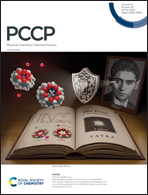Importance of the many-body effects on the structural properties of the novel iron oxide Fe2O†
Abstract
The importance of many-body effects on the electronic and magnetic properties and stability of different structural phases was studied in novel iron oxide Fe2O. It was found that while Hubbard repulsion hardly affects the electronic spectrum of this material (m*/m ≈ 1.2), it strongly changes its phase diagram, shifting critical pressures of structural transitions to much lower values. Moreover, the P![[3 with combining macron]](https://www.rsc.org/images/entities/char_0033_0304.gif) m1 structure previously obtained in the density functional theory (DFT) becomes energetically unstable if many-body effects are taken into consideration. It is shown that these changes are due to magnetic moment fluctuations in the DFT+DMFT (method which combines density functional theory and dynamical mean-field theory) approach, which strongly modify the phase diagram of Fe2O.
m1 structure previously obtained in the density functional theory (DFT) becomes energetically unstable if many-body effects are taken into consideration. It is shown that these changes are due to magnetic moment fluctuations in the DFT+DMFT (method which combines density functional theory and dynamical mean-field theory) approach, which strongly modify the phase diagram of Fe2O.



 Please wait while we load your content...
Please wait while we load your content...